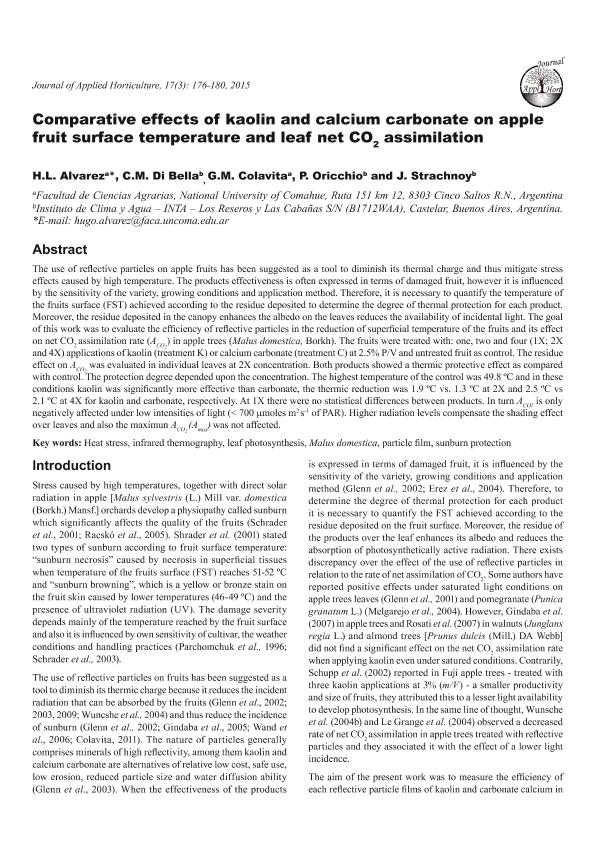Mostrar el registro sencillo del ítem
dc.contributor.author
Alvarez, H. L.
dc.contributor.author
Di Bella, Carlos Marcelo

dc.contributor.author
Colavita, Graciela María

dc.contributor.author
Oricchio, P.
dc.contributor.author
Straschnoy, J.
dc.date.available
2018-08-28T21:52:45Z
dc.date.issued
2015-07
dc.identifier.citation
Alvarez, H. L.; Di Bella, Carlos Marcelo; Colavita, Graciela María; Oricchio, P.; Straschnoy, J.; Comparative effects of kaolin and calcium carbonate on apple fruit surface temperature and leaf net CO2 assimilation; Society for the Advancement of Horticulture; Journal of Applied Horticulture; 17; 3; 7-2015; 176-180
dc.identifier.issn
0972-1045
dc.identifier.uri
http://hdl.handle.net/11336/57454
dc.description.abstract
The use of reflective particles on apple fruits has been suggested as a tool to diminish its thermal charge and thus mitigate stress effects caused by high temperature. The products effectiveness is often expressed in terms of damaged fruit, however it is influenced by the sensitivity of the variety, growing conditions and application method. Therefore, it is necessary to quantify the temperature of the fruits surface (FST) achieved according to the residue deposited to determine the degree of thermal protection for each product. Moreover, the residue deposited in the canopy enhances the albedo on the leaves reduces the availability of incidental light. The goal of this work was to evaluate the efficiency of reflective particles in the reduction of superficial temperature of the fruits and its effect on net CO2 assimilation rate (ACO2 ) in apple trees (Malus domestica, Borkh). The fruits were treated with: one, two and four (1X; 2X and 4X) applications of kaolin (treatment K) or calcium carbonate (treatment C) at 2.5% P/V and untreated fruit as control. The residue effect on ACO2 was evaluated in individual leaves at 2X concentration. Both products showed a thermic protective effect as compared with control. The protection degree depended upon the concentration. The highest temperature of the control was 49.8 ºC and in these conditions kaolin was significantly more effective than carbonate, the thermic reduction was 1.9 ºC vs. 1.3 ºC at 2X and 2.5 ºC vs 2.1 ºC at 4X for kaolin and carbonate, respectively. At 1X there were no statistical differences between products. In turn ACO2 is only negatively affected under low intensities of light (< 700 mmoles m2 s-1 of PAR). Higher radiation levels compensate the shading effect over leaves and also the maximun ACO2 (Amax) was not affected.
dc.format
application/pdf
dc.language.iso
eng
dc.publisher
Society for the Advancement of Horticulture
dc.rights
info:eu-repo/semantics/openAccess
dc.rights.uri
https://creativecommons.org/licenses/by-nc-sa/2.5/ar/
dc.subject
Heat Stress
dc.subject
Infrared Thermography
dc.subject
Leaf Photosynthesis
dc.subject
Malus Domestica
dc.subject
Particle Film
dc.subject
Sunburn Protection
dc.subject.classification
Agricultura

dc.subject.classification
Agricultura, Silvicultura y Pesca

dc.subject.classification
CIENCIAS AGRÍCOLAS

dc.title
Comparative effects of kaolin and calcium carbonate on apple fruit surface temperature and leaf net CO2 assimilation
dc.type
info:eu-repo/semantics/article
dc.type
info:ar-repo/semantics/artículo
dc.type
info:eu-repo/semantics/publishedVersion
dc.date.updated
2018-08-16T18:07:38Z
dc.journal.volume
17
dc.journal.number
3
dc.journal.pagination
176-180
dc.journal.pais
India

dc.description.fil
Fil: Alvarez, H. L.. Universidad Nacional del Comahue; Argentina
dc.description.fil
Fil: Di Bella, Carlos Marcelo. Consejo Nacional de Investigaciones Científicas y Técnicas; Argentina. Instituto Nacional de Tecnología Agropecuaria. Centro de Investigación de Recursos Naturales. Instituto de Clima y Agua; Argentina
dc.description.fil
Fil: Colavita, Graciela María. Universidad Nacional del Comahue; Argentina
dc.description.fil
Fil: Oricchio, P.. Instituto Nacional de Tecnología Agropecuaria. Centro de Investigación de Recursos Naturales. Instituto de Clima y Agua; Argentina
dc.description.fil
Fil: Straschnoy, J.. Instituto Nacional de Tecnología Agropecuaria. Centro de Investigación de Recursos Naturales. Instituto de Clima y Agua; Argentina
dc.journal.title
Journal of Applied Horticulture
dc.relation.alternativeid
info:eu-repo/semantics/altIdentifier/url/http://horticultureresearch.net/journal_pdf/Comparative_effects_of_kaolin_and_calcium_carbonate_on_apple_fruit_surface_temperature_and_leaf_net_assimilation.pdf
Archivos asociados
